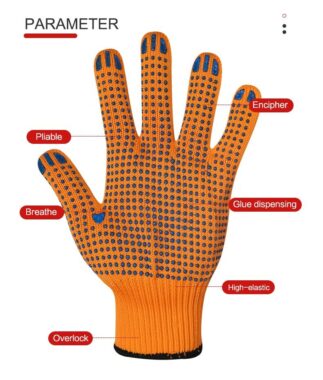Finding the right balance between comfort and protection in work gloves can be tricky, but it’s essential for optimizing performance, safety, and long-term comfort. Here’s a guide to help you strike that perfect balance:
1. The Role of Comfort
Comfort in work gloves primarily refers to how well the glove fits and feels during use. Comfortable gloves allow for better dexterity and less fatigue, enabling you to work longer without feeling restricted. Here’s why comfort is crucial:
- Improved Dexterity: Comfortable gloves offer a snug fit that allows you to move your fingers and hands freely. This is essential for tasks requiring precision, like handling small parts, typing, or manipulating delicate tools.
- Reduced Fatigue: Gloves that are too tight or too loose can cause hand fatigue, making it harder to concentrate on the task. Comfort minimizes this, ensuring you can work for extended periods without discomfort.
- Breathability: Breathable materials (like mesh or knit fabrics) can keep your hands dry and cool, reducing sweating and discomfort during long hours of work.
2. The Role of Protection
Protection refers to how well the gloves safeguard your hands from various hazards such as chemicals, sharp objects, heat, or cold. Here’s why protection matters:
- Preventing Injury: Protective gloves guard against cuts, burns, chemical exposure, and impacts, keeping your hands safe from serious harm in hazardous work environments.
- Material Safety: Protection comes from materials designed to withstand specific risks. For example, nitrile or leather gloves protect against chemicals or abrasions, while cut-resistant gloves prevent injuries from sharp tools or metal parts.
- Environmental Factors: Protection also ensures your hands remain safe in extreme conditions, such as intense heat, cold, or wet environments.
3. The Comfort-Protection Trade-Off
Achieving a balance between comfort and protection means choosing gloves that offer adequate safety while still allowing you to perform tasks efficiently and comfortably. Sometimes, more protection can mean sacrificing comfort, and vice versa. Here’s how to navigate the balance:
- Thicker Gloves vs. Thin Gloves:
- Thicker gloves (like heavy-duty leather or rubber) offer better protection but may be less comfortable and reduce dexterity.
- Thin gloves (like lightweight nitrile or cotton gloves) provide comfort and flexibility but may offer less protection in extreme environments.
- Solution: For jobs with moderate risks, choose gloves that are moderately thick but still flexible (like nitrile-coated gloves). For high-risk jobs, opt for thicker, more protective gloves, but consider using liners or inner gloves for added comfort.
- Liner Gloves for Comfort:
- You can improve the comfort level of protective gloves by adding a soft liner underneath. These can provide padding, moisture-wicking properties, and additional warmth for cold environments.
- Example: A cut-resistant glove with a soft cotton or fleece lining combines the benefits of protection with comfort.
- Choosing the Right Fit:
- Gloves that are too tight will limit comfort and dexterity, while gloves that are too loose may reduce protection and increase the chance of accidents.
- Solution: Always select gloves in the right size for your hands, considering factors like fit, flexibility, and freedom of movement. Gloves with adjustable wrist straps or closures can help achieve a more customized fit.
- Flexible Materials for Better Dexterity:
- Materials like spandex, lycra, or breathable synthetic fabrics allow gloves to conform to the shape of your hand, giving you a more natural feel and greater control. These materials are often combined with protective coatings (like nitrile) to strike a balance between comfort and protection.
- Example: Mechanic’s gloves often use flexible materials for comfort while incorporating tough protective layers at the palm and knuckles for impact protection.
- Temperature Considerations:
- In hot environments, a breathable glove with lighter material (like mesh or cotton) might offer more comfort, but it may not protect well against burns or heat. On the other hand, insulated gloves are ideal for cold environments but may reduce dexterity.
- Solution: In cold environments, opt for gloves with a mix of insulation and flexibility, such as thermal gloves with stretch materials that don’t limit movement.
4. Industry-Specific Balance
Different industries have varying levels of need for comfort and protection:
- Construction: Often requires gloves that combine impact protection (from hard objects) with dexterity for handling tools. Look for leather or rubber-coated gloves that offer protection but have a flexible design.
- Medical and Food Handling: Comfort is often a higher priority here, especially in gloves that need to be worn for long periods. Nitrile or latex gloves provide good comfort but must also be durable and provide protection from contaminants.
- Manufacturing and Warehousing: Protection from sharp edges and heavy equipment is critical. Cut-resistant gloves with breathable liners or coated palms provide the necessary protection without compromising comfort.
- Outdoor/Environmental Work: For cold or wet conditions, waterproof or insulated gloves are important, but flexibility and breathability are key for comfort. Waterproof nitrile or rubber-coated gloves with an insulated lining are a solid choice.
5. Testing and Choosing Gloves
When selecting gloves for a particular task, it’s important to test different types:
- Try them on: Ensure they fit properly and don’t pinch or restrict movement.
- Test the dexterity: Make sure you can perform basic tasks like gripping tools or typing without difficulty.
- Evaluate breathability: Check if your hands stay dry and comfortable during extended wear.
- Consider safety certifications: Look for gloves that meet industry safety standards (e.g., ANSI for cut resistance, CE for European standards).
Conclusion:
The key to finding the right balance between comfort and protection lies in understanding the specific needs of your work and selecting gloves that offer an appropriate level of both. Always prioritize the essential safety features for the task at hand while choosing gloves that won’t compromise your comfort or dexterity. A good pair of gloves should allow you to work efficiently, safely, and comfortably, no matter the job!





















